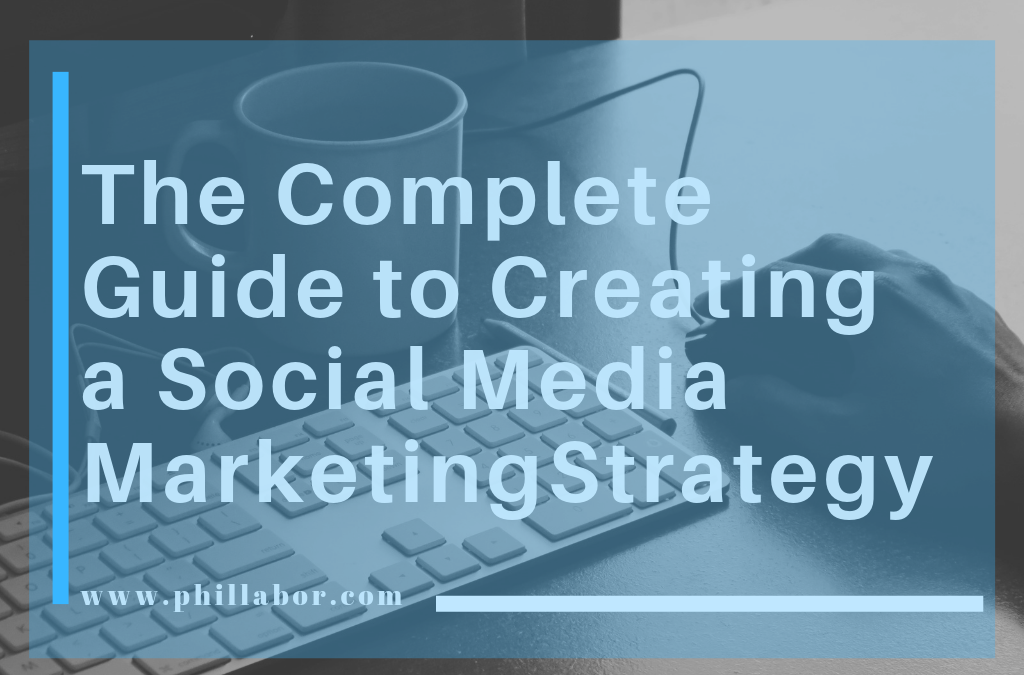Social Media Marketing strategy is really important to any type of businesses. I find this article with Infographics very helpful and I want to share it with you all. I want to thank the author for giving us the complete guide for Social Media Marketing Strategy. Enjoy reading everyone!

Marketing using social media is no longer rocket science. Look around and you’ll find a number of small and big businesses successfully using social platforms to power their social media marketing strategy. It’s definitely a “marketing” tool that’s giving them real-world results, which continues to grow with time.
Now, in order to understand the true benefits of social media marketing and make the most of it, it’s important to understand what all it can help you achieve. In other words, if you only look at social media as a way to grab quick sales, then you’re looking at it with a limited vision.
Social media has the power to help you build a personal connection with your prospects. Yes, it can help you build a relationship that you can leverage to grow your brand, understand your customer’s need and yes, eventually get more business on the table.
Your main goal with social media should be to grow awareness of your products and services – without indulging in any kind of hardcore selling. Or without trying to game the system.

However, the problem is, many small business owners and marketers try to leverage social media without proper planning. And that’s a mistake which can cost you big marketing dollars, and as well as time in the long run.
Having a crystal clear plan is the prerequisite to making social media work for you. You need to know what you’re doing, where you’re headed, and what you plan to achieve with your social media. In short, you need a social media marketing strategy that gives you a bird’s eye view of everything. And at the same time lets you grasp and work with the details when needed.
If you are armed with a solid social media marketing strategy, then it becomes easier to know your customers and also look into how your competition is performing and how you can do things better than them.
 Initially, you may find it challenging to formulate the right social media marketing strategy and execute it well. But once you get a hang of it and start to see the results roll in, you’ll find that the efforts are worth it.
Initially, you may find it challenging to formulate the right social media marketing strategy and execute it well. But once you get a hang of it and start to see the results roll in, you’ll find that the efforts are worth it.
Now, let’s look further into it…
Why Do You Need a Social Media Marketing Strategy?
1. To Grow and Build Your Presence
Regardless of what niche you’re operating in, your business needs an ever-growing presence on the social web. Having a social media marketing strategy will not only help you grow your organic presence, but will also help you maintain your reputation.
When you’re clear about your strategy, you won’t hit the wall and go blank when it comes to posting content to your social media accounts. You’ll be in control of what you post and when, which will allow you to plan out your content well in advance and schedule it for later.
This makes you better than most of your competition because when most of them would be failing to consistently post relevant content, you will be able to stick to your posting schedule. Which is a huge plus on any social network. Because once your consistency hits rock bottom, your social media following starts shrinking and your overall social media presence becomes weaker. In short, your social media marketing strategy helps you plan ahead and get the most out of your content.

2. To Save Precious Hours and Invest Them Where It Matters
Social media marketing can be a time sink for those who are wasting too much time on it — with little returns. Time is critical for a social media marketer, so by creating and implementing the right strategy will let you save a lot of it. Which you can utilize on things that actually matter, such as taking your marketing and business to the next level.
In the beginning, getting everything organized with a content bank and a content calendar may seem to be a time consuming and frustrating process. Because it takes attention to details and great deal of focus. But this will turn out to be a rewarding and productive experience as you move on and get a hold of it.
When you have your content updates neatly sorted and scheduled for the coming days, weeks or months, you will be able to spend more time on tasks that actually contribute to your business’s bottom line.
Last but not the least, when you’re not wasting time trying to figure out what type of content to post, you’ll be able to deeply analyze things that are giving you results.

3. To Achieve Better Audience Targeting
If you want to consistently grow your business, you need to know your audience like the back of your hand. It’s the first step towards building great customer experiences and even greater products.
Today, thanks to social media, understanding your target audience is not as complicated as it used to be. You have the right tools in hand that help you target varied demographics and connect to your prospective audience.
 When creating your social media marketing strategy, understanding your audience can make it more precise and result-oriented. Not only do you get to enhance your relationship with your existing customers, but you also are able to find untapped opportunities.
When creating your social media marketing strategy, understanding your audience can make it more precise and result-oriented. Not only do you get to enhance your relationship with your existing customers, but you also are able to find untapped opportunities.
How?
By analyzing how your target audience behaves and interacts on your choice of social networks. This insight can prove to be a big help, especially when your business is at a growing stage.
Once you understand the value of having a proper social media marketing strategy, it’s time move ahead and execute one by taking the right steps, which discuss below.
Step #1: Set Practical Social Media Goals
Knowing how you are progressing with your social media efforts is crucial if you want to continue moving in the appropriate direction. By properly setting your social media marketing goals, you’ll know how far or how close you are to achieving success.
In order to create practical goals, you can be anything but vague in your approach. You have to have targeted goals. Because these are achievable when compared to the broader, long-fetched ones.

Make sure to set goals that are defined, achievable and measured. This way you’ll be ready to create measurable goals in the main areas of branding and conversions. Your overall social media marketing strategy should include goals that help improve your brand, and boost conversions in the long run.
Here are some social media goals that you could be aiming for.
- Growing your following or community (branding)
- Consistently building a visible brand (branding)
- Connecting and engaging with your existing community (branding)
- Increasing traffic to website (conversions)
- Generating high quality leads (conversions)
- Getting more sales (conversions)
Make sure you’re focusing on the right goals from the beginning. Or else you may not see the kind of results you want to see.
Step #2: Define Your Audience
Connecting to your target customer on social media sites can be a challenge, especially if you’re looking in the wrong direction.
You have to keep in mind that Facebook is different from Twitter, and Twitter isn’t anything like LinkedIn. They all have different types of audiences. They’re different in more than one way. Which is why it is so crucial to define your audience and find out which social network your prospective customers hang out.
And where exactly do they spend most of their time?
 When you’re sure of the social media networks your customers are on and how frequently they can be found there, it becomes easy to reach out to them. Which in turn improves your return on investment.
When you’re sure of the social media networks your customers are on and how frequently they can be found there, it becomes easy to reach out to them. Which in turn improves your return on investment.
Here’s how you can and should connect with your preferred audience on a social media network(s).
1. Know Your Ideal Customer
Without doing so, even the best social media targeting options won’t be of any help. You cannot depend on your instinct or any kind of guesswork. You have to be doubly sure of your ideal customer’s preferred social network.
To do this, create a detailed persona of your ideal customer. This fictional persona can be as detailed as you can make it – the more, the better. It should help you find the right people to connect on social media. Which is the audience that you should be targeting.
 2. Seek Feedback from Your Current Customers
2. Seek Feedback from Your Current Customers
Leverage your existing customers to learn more about their preferences, which you can use to improve your social media marketing. Even if you have a handful of customers from your current business, you can use their knowledge and experience to understand whom to target with your social media marketing campaign.
You can actually survey your customers to learn more about the type of content they consume, why they use your product/service, their habits, what blogs they follow and more importantly the social networks they use etc. Any feedback from your customers should be considered important. The idea is to gain as much clarity as possible. Once you have a complete picture, your overall social media marketing efforts become fruitful, and result-oriented.
3. Research Them
What if your business is new and growing? What if you don’t have any existing customers to survey and learn from? What if your customers are not as responsive as you want them to be?
In any such scenario, you should focus on looking beyond. In other words, start researching into their online behavior and what makes them tick. Try to understand how and where your ideal customers are spending most of their time. And above all, how they’re socializing on various social networks. This data would be crucial to improve your social media marketing.
4. Connect With Them
Once you’re done with the legwork and have detailed results from your survey (or from your research), you should be equipped with the necessary knowledge to leverage the major social media sites for your advantage. In other words, you’ll have what is needed to connect with them and achieve your marketing goals.
Running a social media marketing campaign is only one part of the equation. The other part is tracking it to see if it is effectively working for you. You cannot make the mistake of making any assumptions when it comes successful social media marketing. You should know whether a tactic is giving you results or not before you start losing money. Because after all, you need a positive return on investment from your marketing.
If you want to ensure that your social media marketing is not missing the mark and is right on target, you need to keep track of some key data points.
Let’s look into a few crucial social media metrics below that can help you gain clarity on the effectiveness of your marketing.
1. Volume
Volume is by far the simplest social media metric that you should be measuring. Why? Because it’s not complicated to understand what level of volume (the size of your campaign) is giving you results. One thing that you should be aiming for with your social media marketing is generating interest from your ideal customer. In other words, you want more of your target audience to talk about your brand and/or your overall campaign.
If you analyze the social media arena, you’ll find that people are vocal about both, good and bad experiences. So if you find a ton of tweets mentioning your brand, you’ve got volume that you can analyze to learn more about your customer’s experiences.
 If you truly want to take advantage of this metric, you should go beyond the number of tweets or Facebook comments you’re receiving. You need to properly measure how many different people are distinctly discussing your brand.
If you truly want to take advantage of this metric, you should go beyond the number of tweets or Facebook comments you’re receiving. You need to properly measure how many different people are distinctly discussing your brand.
2. Reach
Every social media conversation surrounding your brand is important. And the more it spreads across the social network, the better your “reach” becomes. So reach is nothing but a metric that lets you understand how far you are able to connect with your audience. It gives you a fair idea of the potential size of your audience, which obviously gives you clarity on improving your approach.
So does “reach” tell you how large your audience is? Yes and no.
Yes because it does tell you if you have a big enough audience, which is good. But it ends right there. The “reach” metric makes more sense when you understand it in correlation to other engagement related metrics such as retweets and replies. In other words, you come to know how many of the people you reached actually engaged with your content.

3. Engagement
One metric that every social media marketer should care about in the engagement metric. The reason being simple: it gives you a strong insight into what your target audience thinks of your brand. Are people just mentioning your brand or are they having multiple conversations about it? Are they actively engaging with the topic? How are they sharing the content with each other?
By looking into the engagement metric, you understand if your social media goals are being met. Because some businesses want engagement in terms of shares, while others want it in terms of replies/likes. Your brand may be after both of these goals.
Either way, it’s good to be clear what you want. If you want to encourage more people to interact with your brand by commenting or replying to your posts, then post content that invokes conversations. And if you want them to people to spread your content, then make sure you add real value to it.
The bottom line is: analyze your engagement metrics based on what you want to achieve from your social media marketing.
Step #4: Conduct a Competitor Analysis
A lot of brands tend to jump into creating content for their social media accounts right away. While producing relevant content is crucial, you do need to find out who your competitors are first, and they are marketing through social media.
When you look into their content creation and distribution strategy, you will learn how you can do something better. Content creation is an integral part of social media marketing, but you have to do it smartly in order to succeed and stay ahead of your competition.
However, it’s important that you do not blatantly copy ideas from your competition. Seeking inspiration is okay, but stealing is not. If you look closely, you will see how and what makes their social media activity workable and more resilient.
You can use Google to find who your competitors are, and then do a social media search to see if they are active on your preferred social network(s). Keep track of their activity and see if you can apply your learning to improve your own social media marketing strategy. Make sure you do this from time to time.
Step #5: Create and Share Quality Social Media Content
Quality content is the backbone of a solid social media marketing strategy. Because without the right kind of content, all other steps would fail to help you reach your marketing goal. On the other hand, if you only focus on content and ignore the other steps we discussed, you may not see favorable results.
Your content can’t be just any content. Regardless of the type of content you share, it has to go with your business goals and brand identity.
 Just the way it is important to share the right content, it’s also important to share it the right way. In other words, you can’t bombard your followers with promotional messages. You have to create a balance between valuable, relevant content and content that is meant to promote your product or service.
Just the way it is important to share the right content, it’s also important to share it the right way. In other words, you can’t bombard your followers with promotional messages. You have to create a balance between valuable, relevant content and content that is meant to promote your product or service.
Social media networking sites are all about people connecting to each other. So the last thing they expect is getting a ton of promotion-oriented messages. If you don’t want to make a bad impression and lose followers, then stay away from sharing too many promotional messages or uninteresting/irrelevant content.
You should also try and share video content with your followers to educate them about your market or about how your products/services can help them. This will not only help them get value but will also make it easy for them to hit the buy button. It’s a win-situation. This is why you find many small and big businesses are adding Facebook videos and Instagram Stories to their social media marketing strategy.

Step #6: Promote Content that is Native to Each Social Media Network
Every social media marketer knows the importance of social media in business. But do also realize the importance of promoting to content via social media the right way. When you’re designing your social media marketing strategy, see to it that you’re not promoting just any content on every network. Your content needs to contribute value towards building the brand and adhere to the audience for that social media platform.
In order to get clicks and leads that convert into customers, you can’t just publish a link to your blog post and expect results. It’s not that simple. You need to give people a reason to take action. How? By taking out the time to create and promote content that is native to the social media platform it is being published on. For example, when you’re posting content on Facebook, you can lay emphasis on getting the user to visit your website or fill out the lead generation form without leaving the page. And when on Twitter, you can focus on using images while asking for a retweet, since tweets with images received 150% more retweets than tweets without images. Similarly, your content promotion strategy should be unique to every social network you’re publishing on. That’s how you get better conversions.
 According to influential author Gary Vaynerchuck, native content is content which adapts to the unique factors of a platform that you are targeting. These factors include but are not limited to the language, culture and style. Which means the content approach that works for you on LinkedIn may not work well on Facebook, and vice versa. Since the way people interact with each other on these platforms is different, their response will also vary.
According to influential author Gary Vaynerchuck, native content is content which adapts to the unique factors of a platform that you are targeting. These factors include but are not limited to the language, culture and style. Which means the content approach that works for you on LinkedIn may not work well on Facebook, and vice versa. Since the way people interact with each other on these platforms is different, their response will also vary.
Conclusion
Last but not the least, your brand needs to be authentic in its approach in order to find success with social media marketing. There’s no replacement for being authentic and real, it gets you closer to your customers and grows your business.
The best part about social media is, it gives you the opportunity to be yourself. Even when you’re using something like Facebook Ads, you’re able to go beyond just “selling”, and present the personal side of your business.
# 20 – Managing your diary that includes scheduling appointments, accepting invitations and sending reminders to attendees prior to meetings, saving you time and letting you focus on what is important
# 21 – Handling your email inbox to sort out and prioritize your emails, making sure you do not miss out on anything that needs urgent action or a potential business opportunity
# 22 – Handling bookkeeping tasks such as invoicing, reconciliations and recording of receivables, among others
# 23 – Managing your projects using tools such as Asana and Trello and reporting back to you on the progress, timeline and people responsible for each task
# 24 – Managing your E-commerce platform by uploading or updating your product listings, writing and editing descriptions and optimizing them for better online visibility
# 25 – Documenting your business processes using systemHUB to reduce key person dependency














































Recent Comments